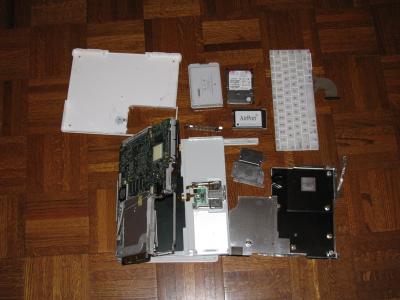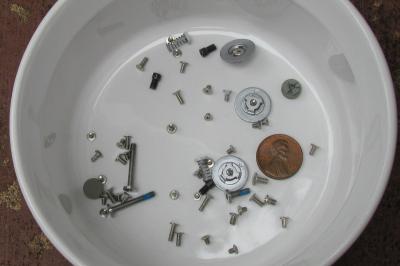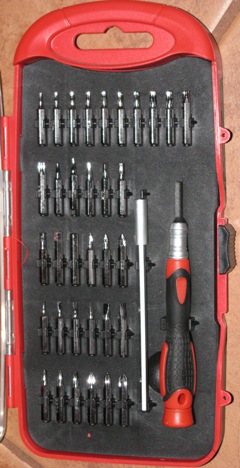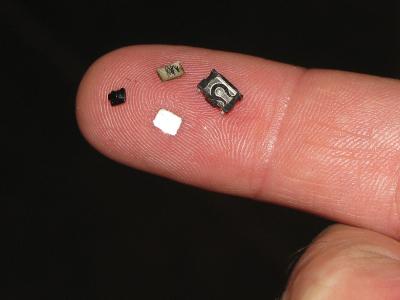Archos Jukebox Upgrade
One of the advantages of the Archos is that it uses a standard notebook hard drive, specifically a 2.5 inch ATA hard drive (current notebooks use SATA drives which are not the same). So ever since I bought it, I knew there was the tantalizing possibility of upgrading the hard drive to something bigger than the original 20 GB. When I wrote an entry about looking for a cheap used hard drive, Jeb offered up his broken iBooks as possible sources of a new drive. One problem was he didn't remember how big the hard drives were and Apple doesn't give iBooks model numbers to help find out (Dell gives every computer a service tag which allows you to at least look up the original configuration for that specific computer).
Today Jeb brought three old iBooks over to Mom's, including one that was owned by Danny but was ruined because of water damage and therefore might have an unusable hard drive whereas the other two had problems independent of the hard drive. We figured out that one of the laptops probably had a 30 GB drive and the other a 40 GB drive. So we opened up the "dual USB iBook" using some online instructions I found. Other instructions said do not attempt a hard drive replacement with this particular iBook because it was simply too difficult. Fortunately, since I didn't have to put it back together and make it work again, I didn't have to worry about where the 50 or more screws I had to remove had to go and where all the parts would go again. It took an hour or more to get to the hard drive which was hidden under several layers of stuff that had to be removed from both the top and bottom of the notebook body.
Once I was able to retrieve the hard drive (turned out to be a 40 GB Hitachi Travelstar) and undo some spacer bolts from the sides, I fit it into the Archos, which I had taken apart Thursday night by following some some good instructions and some better ones.
Now the trick is to format the hard drive since the Archos only recognizes hard drives that have been formatted using FAT32. The problem with that is computers running Windows XP or Vista won't format drives that way. So I had to use my old Dell Dimension 4100 that has Windows 98 on it. For some reason it would act like it was recognizing the Archos, but it wouldn't show up as a drive. I went into Device Manager and picked the properties for the disk drive, checked a box to make it removable, restarted the computer, and it would see the drive. I was able to format it no problem and I had about 38 GB available! Then I hooked it up to my laptop so I could put some music on it and try it out. I put the system files on it and a few songs. But after I disconnected it from my laptop and tried to play a song, I got some kind of error saying it couldn't save files and it asked me if the battery was low. I'd never seen that before. I tried a few different things and kept getting the same problem. Then I headed home. Jeb said he would just throw away the other iBooks, so I said I would take them and turn them in on an electronics recycling day sometime.
At home I reformatted the hard drive, did a thorough scan, and put files back on it and got the error again. So I downloaded the latest Rockbox software and put that on there and it worked no problem! I'm not sure why older Rockbox software isn't compatible, but I tried several older versions and none of them worked. The only thing I don't like about the new version is that it doesn't show me a % readout when I change the volume. I think it is supposed to show dB, but instead it just says "Vol: " with a blank space. The only way you know the volume is changing is by looking at the little LCD volume icon which only has 4 bars. I started transferring files over to it. It uses an older version of USB, so it doesn't transfer data that fast. One gigabyte probably takes about 20 to 30 minutes to transfer. The only thing about it is that I don't think the Archos driver is that good because if I go to Safely Remove the drive, I get a long, long delay. I tried shutting the computer down so it would finally release the drive, but I think it just takes about 10 minutes and you have to wait. Fortunately I won't have to do this that often.
So this was pretty cool having a 40 GB MP3 player. But it was all just too easy. So I decided I should look up the serial number on Danny's laptop and see what kind of hard drive it might have. It was almost certainly 60 GB. I looked for instructions to see if it was easier to get the hard drive out, but it was almost an identical process as before (a little bit better, though Apple still hides screws under magnets and cables to make them hard to find). So 50 screws later I had a 60 GB hard drive, stuck it in the Archos, did the device manager thing again, formatted the drive, stuck the new operating system on it, transferred some music and viola! Now a 60 GB Archos!
The picture above shows all of the screws I took out of the second iBook (not the penny, that is for perspective).
Thanks, Jeb!






